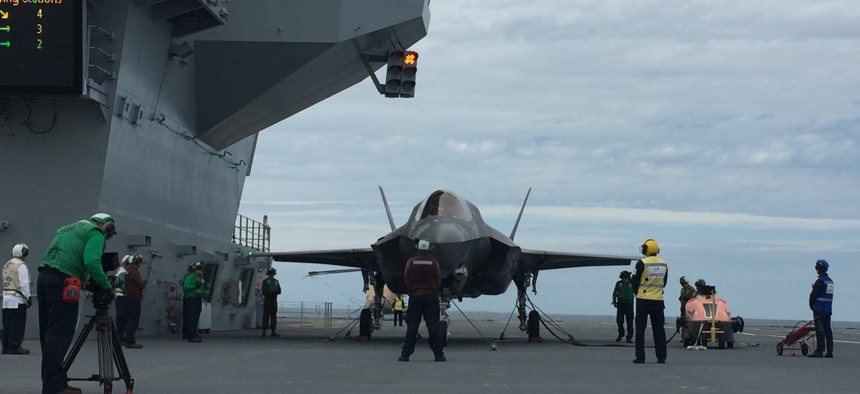
A U.S. Marine Corps F-35 fighter jet on the HMS Queen Elizabeth during flight testing in 2018. Marcus Weisgerber/Defense One
UK Confirms Plans to Add F-35s, But Won’t Commit to Original Goal
Officials have promised to buy 48, are thinking about buying more, but wouldn’t say whether the 138-plane vision will ever be realized.
As the U.S. military reevaluates how many F-35 stealth fighters it needs in its future combat force, America's closest ally is following suit and won’t commit to buying the full number it originally planned.
The Royal Air Force is also evaluating its combat warplane mix, a top U.K. defense official said Monday.
“I think that there's a discussion on going over what the exact shape of the fast air force looks like in the future,” James Heappey, the U.K. armed forces minister, said on a Monday conference call.
In the meantime, the UK is planning to increase spending on a newer, indigenously-made stealth fighter. UK officials announced Monday that they would invest more than £2 billion ($2.77 billion) over the next four years to develop the Tempest Future Combat Air System concept, which itself is part of a larger effort to modernize London’s forces for “an era of global competition and security threats.”
The moves were part of a new defense strategy announced by U.K. Defense Secretary Ben Wallace on Monday. That plan calls for spending more than £85 billion on new weapons over the next four years.
“We recognize that if the U.S. now has to look towards the Pacific and China, that actually Europe needs to step up and spend what it should on defense, so that it can take care of its own backyard,” Heappey said. “We do [and] we’ll lead others to try and get them to do likewise. But we will also be with [the U.S.] in that competition in the Indo-Pacific, because we recognize that a global ambition for the United Kingdom requires us to be there too.”
The new strategy calls for adding. nuclear weapons, and shrinking the British Army, and creating new Ranger Regiments within the Special Forces. It also calls for retiring the Royal Air Force’s Lockheed Martin C-130J tactical transport planes, and relying instead on European-made Airbus A400M cargo aircraft. The Royal Air Force describes the C-130 as “the backbone of UK operational tactical mobility tasks” since 1999.
As for the F-35, the strategy calls for “increasing the fleet size beyond the 48 aircraft that we have already ordered,” but Heappey would not say whether buying 138 jets remains the goal.
“We've committed to 48; we'll buy 48,” Heappey said.
While U.S. Air Force officials call the F-35 the “cornerstone” of its future combat fleet, the Pentagon is debating whether to accelerate a secret project to develop new combat aircraft.
The U.K. is buying the short-takeoff, vertical-landing version of the F-35 largely flown by the U.S. Marine Corps. The Royal Air Force has ordered 48 F-35B fighters that will fly from the Royal Navy’s two new aircraft carriers, the HMS Queen Elizabeth and HMS Prince of Wales.
The U.K. aircraft carriers are built to carry at least 40 F-35s. U.S. Marine Corps F-35s will be onboard Queen Elizabeth’s first deployment to the Pacific later this year.







